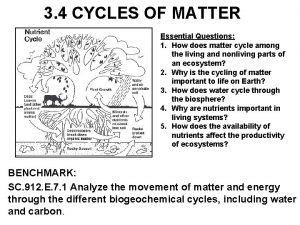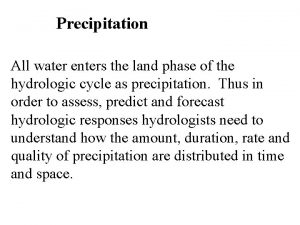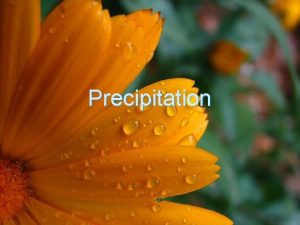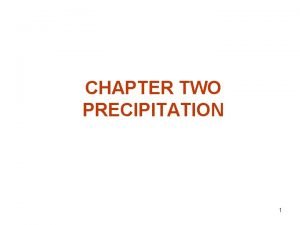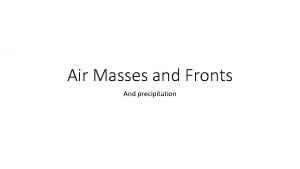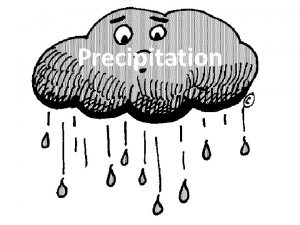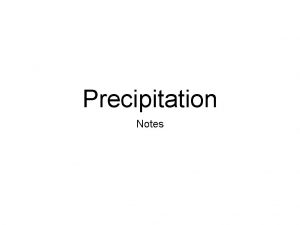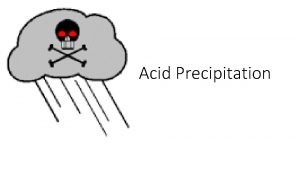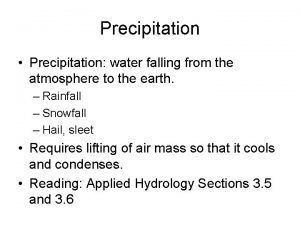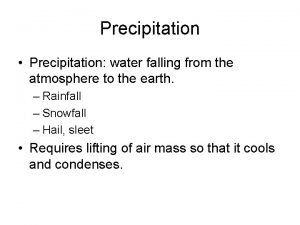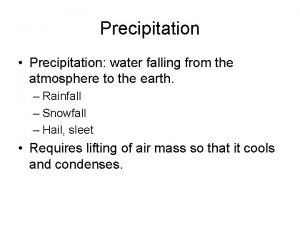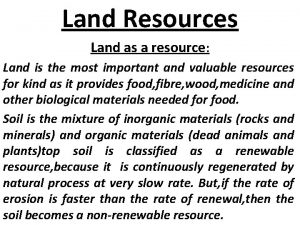Precipitation All water enters the land phase of


























- Slides: 26

Precipitation All water enters the land phase of the hydrologic cycle as precipitation. Thus in order to assess, predict and forecast hydrologic responses hydrologists need to understand how the amount, duration, rate and quality of precipitation are distributed in time and space.

Water Vapor in the Atmosphere • The atmosphere a critical pathway in the hydrologic cycle • The transport and distribution of water vapor in the atmosphere controls precipitation and evaporation which in turn determine soil and groundwater storage and runoff

Ralph, F. M. , P. J. Neiman, G. A. Wick, S. I. Gutman, M. D. Dettinger, D. R. Cayan, and A. B. White (2006), Flooding on California's Russian River: Role of atmospheric rivers, Geophys. Res. Lett. , 33, L 13801, doi: 10. 1029/2006 GL 026689.

Learning objectives • Describe the physical processes involved in the formation of precipitation • Identify and describe the meteorological patterns that give rise to precipitation in different parts of the world Reading • Dingman Chapter 4

Meteorology of Precipitation • Precipitation requires – Cooling to below dew point – Condensation nuclei – Drop growth • Primary cooling mechanism is uplift • Precipitation amounts frequently larger than precipitable water – Requirement for supply of water vapor – Convergence and uplift • Weather systems – – – Extratropical cyclone/frontal system Intertropical convergence zone Hurricane Convection (Thunderstorms) following surface heating. Orography

From Dingman, 1994

Seasonal movement of the Earth's global circulation patterns. Pidwirny, M. (2006). "Tropical Weather and Hurricanes". Fundamentals of Physical Geography, 2 nd Edition. Viewed 9/22/08. http: //www. physicalgeography. net/fundamentals/7 u. html

From Brutsaert, 2005

From http: //www. physicalgeography. net/fundamentals/7 s. html

From Bras, 1990 From Dingman, 1994

From Dingman, 1994

Hurricane Floyd, September 15, 1999 Graphical model showing a vertical cross-section of the air circulation, clouds, and precipitation associated with a hurricane. From http: //www. physicalgeography. net/fundamentals/7 u. html

From Bras, 1990

From Brutsaert, 2005

Precipitation Measurement and Data Analysis Learning objectives • Be able to estimate area average precipitation from point measurements using a variety of methods • Estimate design rainfall amounts and intensities • Develop Arc. GIS skills for analysis of precipitation

Precipitation measurement at a point Accuracy is an important foundation for quantitative hydrologic analysis Issues affecting precipitation measurement accuracy (gage design considerations) (Dingman p 105 -115) – – – – Orifice size Orifice orientation Height above ground Wind shielding Obstructions (buildings, trees etc. ) Splashing (in or out) Evaporation of collected water

Standard Rain Gage Specifications From Dingman, 1994

Wind effects and shields From Dingman, 1994

Avoid obstructions to gages. Reduce splash effects From Dingman, 1994

Gage-catch deficiencies From Dingman, 1994

Precipitation area averaging From Dingman, 1994

Arithmetic Average From Dingman, 1994

Thiessen Polygons From Dingman, 1994

Isohyetal method From Dingman, 1994

Hypsometric Method From Dingman, 1994

From www. prism. oregonstate. edu
 Steps of gravimetric analysis
Steps of gravimetric analysis Co precipitation and post precipitation
Co precipitation and post precipitation Water and water and water water
Water and water and water water Types of water forms
Types of water forms Cycling of matter in an ecosystem
Cycling of matter in an ecosystem Name three lines
Name three lines An area of land largely enclosed by higher land
An area of land largely enclosed by higher land Identifying landforms
Identifying landforms Normal phase vs reverse phase chromatography
Normal phase vs reverse phase chromatography Tswett pronunciation
Tswett pronunciation Mobile phase and stationary phase
Mobile phase and stationary phase Mobile phase in chromatography
Mobile phase in chromatography Normal phase vs reverse phase chromatography
Normal phase vs reverse phase chromatography Line current and phase current
Line current and phase current Which detector used in hplc
Which detector used in hplc Phase to phase voltage
Phase to phase voltage Broad phase vs narrow phase
Broad phase vs narrow phase Spacing letter format
Spacing letter format Canada enters ww2
Canada enters ww2 Nombres naturals exercicis
Nombres naturals exercicis When white light enters a prism
When white light enters a prism Ei=ef physics
Ei=ef physics Nombres enters primaria
Nombres enters primaria Any harmful material that enters the biosphere is a
Any harmful material that enters the biosphere is a Https //talenttransformation.wipro com
Https //talenttransformation.wipro com I am the gate whoever enters
I am the gate whoever enters What does the hearth and the salamander mean
What does the hearth and the salamander mean




